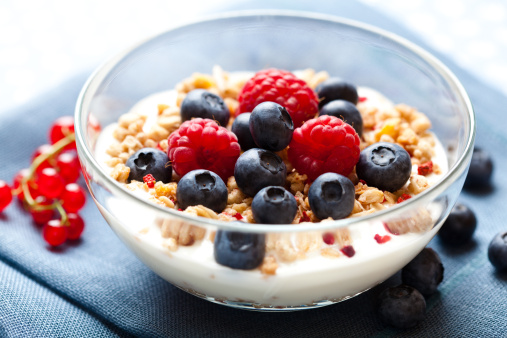Kim Albritton, MS, RDN, LDN
In the last ten years, yogurt has boomed in popularity and the options in the yogurt aisle at the grocery store seem to be endless with options such as regular, full fat, 2%, nonfat, Greek, Icelandic, plant based, squeezable, bottles, and so on. Who knew picking a yogurt could be so confusing?
Yogurt is included on healthy food lists because it is an excellent source of protein and calcium, provides numerous vitamins and minerals, and is generally low in calories. Yogurt also includes probiotics, which can help maintain the balance of bacteria necessary for a healthy digestive system, boost the immune system, and possibly shortening the length and severity of sickness. This nutrient profile is of interest in relation to aging, which is accompanied by a wide array of nutritional deficiencies and health complications associated with nutrition. Yogurt’s live and active cultures also make it a more easily digestible option for people with lactose intolerance.
The most popular yogurts we focus on are generally plain yogurt vs Greek yogurt…however there are quite a few other great options in your local supermarket. What is the difference and which one should you buy? The following summaries of different yogurt varieties outline what makes each one unique.
Traditional
Yogurt: Fat Free / Low Fat / Full Fat
What it is: Traditional American-style yogurt is unstrained and
made from whole, low-fat, or nonfat milk. Because it’s unstrained, it is much lower
in protein compared with strained varieties such as Greek, Icelandic, French,
or Australian yogurt. Traditional yogurt has a smooth and creamy texture.
Popular brands: Yoplait, Stonyfield, and Dannon.
Greek
What it is: Greek yogurt is a thick, creamy yogurt that’s been
strained to remove the whey. Most Greek yogurts have twice the protein of
regular low-fat yogurt. You can often find full-fat, low-fat, and fat-free
varieties.
Popular brands: Chobani, FAGE, and Dannon Oikos.
Icelandic
What it is: Icelandic yogurt, also known as skyr, is a strained
yogurt that’s creamier and thicker than Greek yogurt. In fact, it takes almost
four cups of milk to make one cup of Icelandic yogurt, which is why it contains
more protein than regular yogurts.
Popular brands: Skyr, and Siggi’s.
Australian
What it is: Australian yogurt is unstrained. It’s made with whole
milk and typically sweetened with honey. It has a velvety, creamy texture and
has been described as in between Greek-style and traditional-style yogurts.
It’s lower in protein than Greek yogurt but higher than traditional yogurt.
Popular brands: Noosa and Wallaby.
French
What it is: “French-style yogurt is a thick unstrained yogurt
in keeping with the trend of full-fat dairy.
Each serving is individually cultured for eight hours in the same glass
pot from which consumers will eat. Although it’s often compared with Greek
yogurt because of its thick consistency, French yogurt has less protein than
Greek and can contain more sugar.
Popular brands: Oui by Yoplait.
Kefir
What it is: Kefir is a fermented milk drink. It is produced when
milk and kefir grains (cultures of bacteria and yeast) interact. It has a tart, tangy taste. Strained kefir,
available in spoonable cups, has a creamy texture similar to Greek yogurt with
up to twice as many probiotics. Kefir can be found in full-fat or nonfat and
plain or flavored varieties.
Popular brands: Lifeway, The Greek Gods, and Ludwig Dairy.
With the many yogurt options out there, what should you consider when picking a yogurt?
- Probiotic Content
Not all yogurts actually contain the beneficial bacteria. If you do not see Streptococcus thermophilus and Lactobacillus bulgaricus, keep looking. The container should say “contains active cultures” or “living cultures”. Yogurts without these will contain additives and extra sugary ingredients you do not need.
- Simple Ingredient List
Milk and live active cultures should be all that you need for a nutrient rich yogurt. Anything more is extra. Be careful to avoid added sugars or artificial sweeteners…. look for words like sugar, agave, nectar, honey,
- More Protein than Carbs
Look for a yogurt with at least 15g of protein and no more than 6-8g carbs. For higher protein options, choose Greek, Icelandic, French, or Australian yogurts.
Remember that yogurt is versatile and nutrient dense and can not only be used as a snack but as substitutes or bases for other ingredients or recipes. Try it as:
- A substitute for sour cream and mayonnaise.
- A substitute for cream in soups.
- A supplement to smoothies for creamy texture and protein.
- A substitute for butter – use plain, low fat Greek yogurt in place of half the amount of butter called for in a recipe.
- A base for dips and salad dressings.
